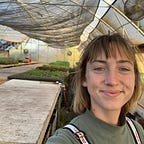Survival for Living Beings in February
It’s the middle of February in Ohio again. Whoops. The skies have been gray for about a month too long and the ground is melting into one giant, dirty puddle of despair. How dramatic! February has felt like this every year of the past four that I’ve spent living in Dayton. No matter how hard I try (do I try that hard?), the middle of February creeps up again, tempting me to sit down and put my cynical thoughts on display. How many things can I spiral about before I move on to how many things make me angry before tucking myself into a nice night of giving up? Nothing matters in February, but everything feels like it might fall apart?
There’s a whole other side of this season that I love. It’s a slow moment on the farm. There’s some work to do, but a calming amount. February comes after you’ve closed up shop on the fields, tucked the garlic away under layers of mulch, flipped on the heat, and rolled up the greenhouse sides, right when you feel like you could sleep for a month straight. It’s the time of year when you get to think about everything that went well last June and everything that absolutely sucked in August. Did we really grow 25,000 pounds of red slicer tomatoes out of just two greenhouses? Amazing! Did we really only have three people to harvest those tomatoes in August? That was awful, let’s grow fewer tomatoes and hire more interns. It’s a month to breathe and pause and think and summon the energy for the next season. The slowness of it is just enough to make you start to itch for the buzz of Spring.
I’ll admit that some of the farming in this season causes me to worry, mainly because of the space my mind has to wander. Like, what if the lettuce in our greenhouses gets drowned out by aphids? Or, what if I can never figure out how to get spinach to germinate at a reasonable rate? It’s odd to go into work and not have plants setting the pace for you. In the summer you have to harvest summer squash and cucumbers every other day, tomatoes and peppers twice a week, eggplant at least once a week — there’s less time to think about what you should be doing. You observe the plant and make a quick decision. This month I ask myself what I can be doing to make those harvests in June easier, how to avoid a disaster at the end of July, search madly for places to find hardworking interns. The worry might also be due to an uptick in coffee consumption on colder days.
After a particularly cold day, people might comment, “I’m sorry, it must have been so cold for you at work today!” and the reality is that very rarely if ever am I working in a field in February. It’s much colder to harvest radishes on a rainy day in October or plant onions on a windy morning in March. There’s not much to do outside right now, a tractor would never make it in the field, nor would a plant. Sometimes, I’ll walk the perimeter of the fields, just to check different areas out. It feels like visiting a graveyard. Freeze-dried eggplants hanging from frozen stalks, shriveled cabbages interspersed among some anemic weeds hanging on through single-digit nights. The fields look brutalized. King Fahrenheit just waged a war and came home a victor. But a short victory, because we know what will happen in another month or two, we know that there are thousands of plants growing in a nursery waiting for the temperature to perk up. The ice will melt, the puddle from the ice will dry up enough to drive a tractor through, at some point, it will even be warm enough to put a tomato plant outside in a field and have it blossom.
I’m relatively new to farming, this being my fifth year, but I’ve already begun to feel much safer with the life cycle of a plant than anything else. My attachment to plants and their patterns is much more secure than people or any other part of being an adult. I can trust the frozen field in February to be a blooming field in May. And on days when my mind is running a bit too fast, I pull out my best trick. Do you know winter's greatest survival tactic? Wait a few hours for the sun to warm up a greenhouse and then take a few moments inside, let your arms and face warm up, smell that odd greenhouse smell. It’s a balm to frayed nerves of all kinds.
I don’t know, now I feel a bit silly for sharing some of these things, but I suppose I will leave them in case anyone else needs someone to feel silly with. Happy February, thank god it’s a short one.
